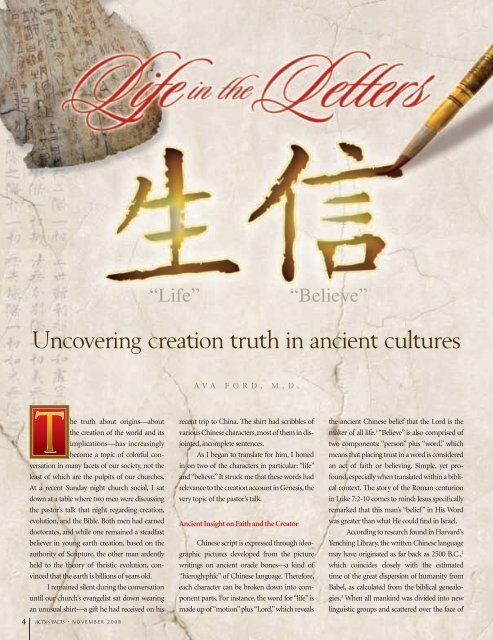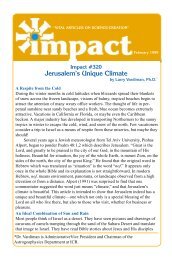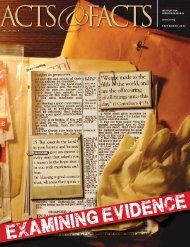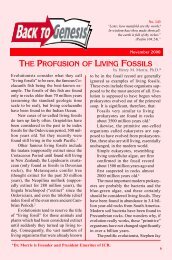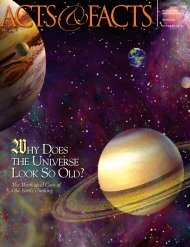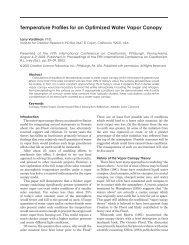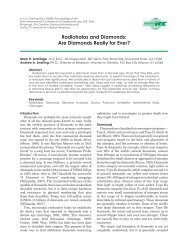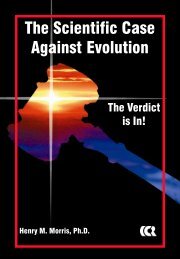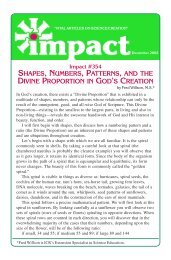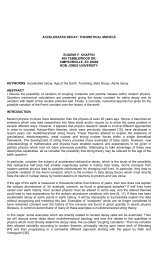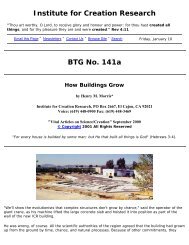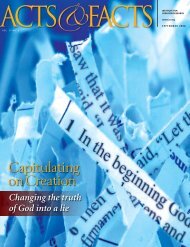Uncovering creation truth in ancient culturesAva Ford, M.D.he truth about origins—aboutthe creation of the world and itsimplications—has increasinglybecome a topic of colorful conversationin many facets of our society, not theleast of which are the pulpits of our churches.At a recent Sunday night church social, I satdown at a table where two men were discussingthe pastor’s talk that night regarding creation,evolution, and the Bible. Both men had earneddoctorates, and while one remained a steadfastbeliever in young earth creation, based on theauthority of Scripture, the other man ardentlyheld to the theory of theistic evolution, convincedthat the earth is billions of years old.I remained silent during the conversationuntil our church’s evangelist sat down wearingan unusual shirt—a gift he had received on his4 ACTS&FACTS • NOVEMBER 2008recent trip to China. The shirt had scribbles ofvarious Chinese characters, most of them in disjointed,incomplete sentences.As I began to translate <strong>for</strong> him, I honedin on two of the characters in particular: “life”and “believe.” It struck me that these words hadrelevance to the creation account in Genesis, thevery topic of the pastor’s talk.Ancient Insight on Faith and the CreatorChinese script is expressed through ideographicpictures developed from the picturewritings on ancient oracle bones—a kind of“hieroglyphic” of Chinese language. There<strong>for</strong>e,each character can be broken down into componentparts. For instance, the word <strong>for</strong> “life” ismade up of “motion” plus “Lord,” which revealsthe ancient Chinese belief that the Lord is themaker of all life. 1 “Believe” is also comprised oftwo components: “person” plus “word,” whichmeans that placing trust in a word is consideredan act of faith or believing. Simple, yet profound,especially when translated within a biblicalcontext. The story of the Roman centurionin Luke 7:2-10 comes to mind; Jesus specificallyremarked that this man’s “belief” in His Wordwas greater than what He could find in Israel.According to research found in Harvard’sYenching Library, the written Chinese languagemay have originated as far back as 2500 B.C., 2which coincides closely with the estimatedtime of the great dispersion of humanity fromBabel, as calculated from the biblical genealogies.3 When all mankind was divided into newlinguistic groups and scattered over the face of
the earth, ancient Chinese people would havealso carried with them an accurate account ofearly human history. Their knowledge of creationand the great Flood had to be fresh intheir minds since they were likely contemporariesof Noah, who lived <strong>for</strong> 350 years after theFlood (Genesis 9:28) and knew all the details ofcreation through his own father, Lamech, whowas only 56 years old when Adam died. With lifespans averaging about 912 years in that era, hewould have been considered a relatively youngman (Genesis 5:1-11).Interestingly, the ancient Chinese recordFeng-su T’ung-yi (Comprehensive Meaningof Customs) states that all people on earth aredescended from “Nu-wa.” (Some have suggestedthis to be a version of the biblical nameNoah, as found in other ancientChinese texts.) 4 The Chinese were“known <strong>for</strong> meticulous recordkeepingfrom the time of the Hsia Dynastyin 2205 B.C., and according totheir most acclaimed set of ancientmanuscripts, Shu Jing (The Book ofHistory), many generations of Chineseemperors recited texts of praise during theannual Border Sacrifice as they brought theirpeople together to worship “Heavenly SovereignShangDi,” the Creator of the universe andthe one true God. 5Of old in the beginning, there was the greatchaos, without <strong>for</strong>m and dark. The five elements(planets) had not begun to revolve,nor the sun and the moon to shine. In themidst thereof there existed neither <strong>for</strong>msnor sound. Thou, O spiritual Sovereign,camest <strong>for</strong>th in Thy presidency, and firstdidst divide the grosser parts from thepurer. Thou madest heaven; Thou madestearth; Thou madest man. All things withtheir reproducing power got their being. 6Sounds remarkably similar to Genesis,doesn’t it?Acknowledging the Creator through ScienceWhen you look at our beautiful planetearth, the changing colors in its seasons, and allits diverse, complex, interdependent creaturessustained by sophisticated ecosystems, haveyou ever stopped to wonder how it all came tobe? Who set it all in motion and why?Growing up in an unbelieving home,I was quite ignorant of the concept of God asCreator. In school I was only taught CharlesDarwin’s theory of evolution: that all life <strong>for</strong>msevolved from a single cell. However, when I enteredmedical school, and particularly duringanatomy class, I began to seriously questionits validity. Each day I encountered the intricaciesof the human body and something withinme demanded an honest appraisal of Darwin’stheory. I really wanted to know the true accountof man’s beginning. But none of my professorscould give satisfactory answers to my questions.I got my first glimpse of the Genesis accountduring a grueling 10-day mountainclimbing expedition through a region calledthe “Valley of Death.” At one point during theclimb, we were <strong>for</strong>ced to spend a night in a caveL ife” does not come through faithin the science of men, but through“belief ” in the Creator of life, Jesus Christ.because of a heavy rainstorm. In that cave, oneof my teammates introduced me to the book ofGenesis and the God of the Bible.It wasn’t until months later when I beganto attend a Bible study with this same studentthat I heard the full story of the creationof the universe, the first man and woman, theinstitution of marriage, the temptation andfall, death as the consequence of sin, God’sworldwide judgment through the Flood, thetower of Babel and the subsequent dispersionof humans through the confusion of manylanguages. As I studied, my excitement in theBible grew. Not surprisingly, most of my classmatesat medical school laughed at my enthusiasm<strong>for</strong> these new discoveries, which theyconsidered to be no more than fairy tales suited<strong>for</strong> children, not <strong>for</strong> scientifically-minded,educated people.So I began to search <strong>for</strong> evidences outsidethe Bible, mainly through books on archaeology.I recall at this time in the late ’70s that the mediawas buzzing about the cunei<strong>for</strong>m discoveries atTel Mardikh (Ebla), on clay tablets dating backto 2250 B.C. Many scholars suggested parallelswith the early chapters of Genesis, sheddingnew light on the credibility of the Bible. Namesof biblical patriarchs were recorded, as well as a“creation hymn.” I found through other bookson fossils, geology, astronomy, history, ancientlanguages, and medicine, much more evidenceI could not simply brush aside—evidence thatsubstantiated the veracity of Genesis, which ledme to place my trust in the authority of God’sWord, to “believe” the Bible accounts from Genesisthrough Revelation as literal truth. In time,by God’s grace, this confidence in the Scripturesled me to personal faith in the Lord Jesus.Critics of the CreatorThere are, I know, many well-meaningand well-educated Christians today who strugglewith belief in the Genesis record. Sadly, theyhave placed more trust in science—in the wordsof men—than in Scripture. Tothese critics of the Creator I wouldask if they consider themselvesmore qualified than the patriarchJob to answer the hard questions ofGod (Job 38-42). With all his wisdom,Job could only reply, “Whatshall I answer thee? I will lay minehand upon my mouth” (Job 40:4).It is both dangerous and dishonoring toGod when His own people attempt to “spiritualize”the Scriptures in order to make them fitthe musings of men (Job 36:26; 37:1-24). Scienceand its resultant evidence are vital <strong>for</strong> theprogress of our God-given stewardship of theearth, but these must never be placed over theauthority of God.“Life” does not come through faith in thescience of men, but through “belief” in the Creatorof life, Jesus Christ. 7References1. Compare Colossians 1:15-17.2. Kang, C. H. and E. R. Nelson. 1979. The Discovery of Genesis:How the Truths of Genesis Were Found Hidden in the ChineseLanguage. St. Louis, MO: Concordia Publishing House, xiii.3. Johnson, J. J. S. 2008. How Young Is the Earth? Applying SimpleMath to Data Provided in Genesis. <strong>Acts</strong> & <strong>Facts</strong>. 37 (10).4. Truax, E. A. 1991. Genesis According to the Miao People. <strong>Acts</strong>& <strong>Facts</strong>. 20 (4).5. Compare Psalm 74:17; <strong>Acts</strong> 17:26-27.6. James Legge, The Notions of the Chinese Concerning God andSpirits (Hong Kong: Hong Kong Register Office, 1852), page28, as cited in Kang, C. H.and E. R. Nelson. 1979. TheDiscovery of Genesis: How theTruths of Genesis Were FoundHidden in the Chinese Language.St. Louis, MO: ConcordiaPublishing House, 15.7. John 3:14-16; 20:31.Dr. Ford has served in medicalmissions on three continentssince 1985.NOVEMBER 2008 • ACTS&FACTS5


